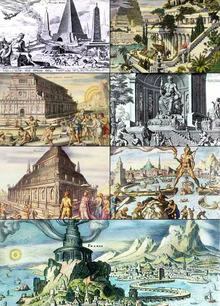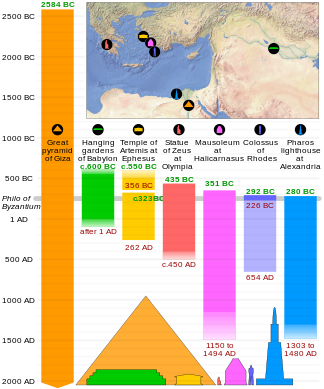
Back Siete Marabellas de lo Mundo AN عجائب الدنيا السبع Arabic Siete maraviyes del mundu vieyu AST Dünyanın yeddi möcüzəsi Azerbaijani Донъяның ете мөғжизәһе Bashkir Сем цудаў свету Byelorussian Сем цудаў сьвету BE-X-OLD Седемте чудеса на античния свят Bulgarian প্রাচীন বিশ্বের সপ্তাশ্চর্য Bengali/Bangla Seizh Marzh an Henved Breton


The Seven Wonders of the Ancient World, also known as the Seven Wonders of the World or simply the Seven Wonders, is a list of seven notable structures present during classical antiquity. The first known list of seven wonders dates back to the 2nd–1st century BC.
While the entries have varied over the centuries, the seven traditional wonders are the Great Pyramid of Giza, the Colossus of Rhodes, the Lighthouse of Alexandria, the Mausoleum at Halicarnassus, the Temple of Artemis, the Statue of Zeus at Olympia, and the Hanging Gardens of Babylon. Using modern-day countries, two of the wonders were located in Greece, two in Turkey, two in Egypt, and one in Iraq. Of the seven wonders, only the Pyramid of Giza, which is also by far the oldest of the wonders, still remains standing, while the others have been destroyed over the centuries. There is scholarly debate over the exact nature of the Hanging Gardens, and there is doubt as to whether they existed at all.
© MMXXIII Rich X Search. We shall prevail. All rights reserved. Rich X Search